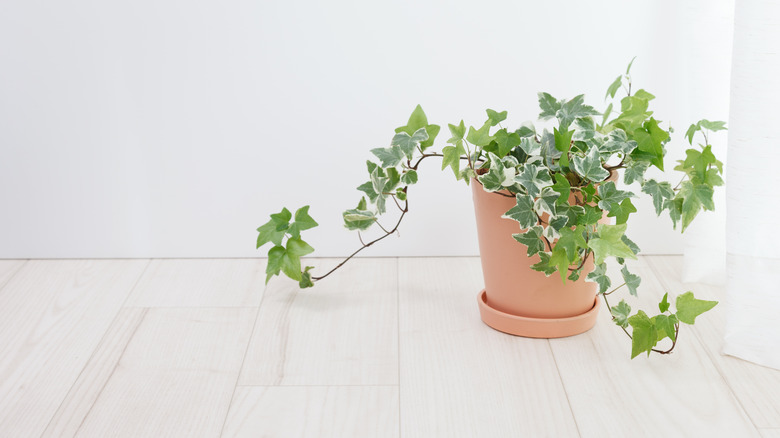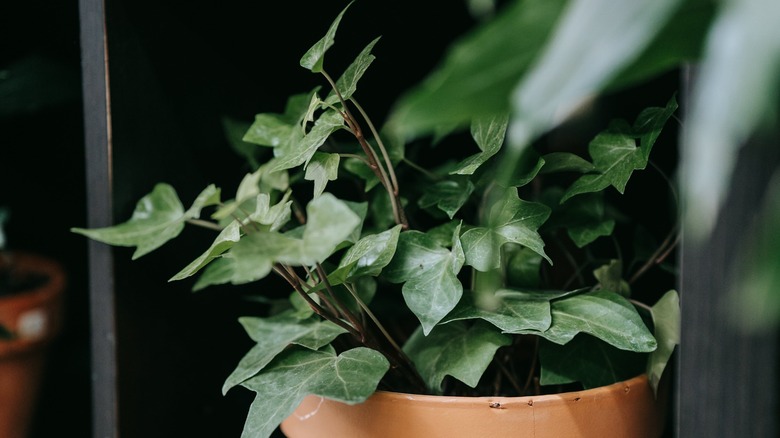Airborne mold spores can be dangerous to humans inside homes — when inhaled, they cause allergic reactions, respiratory problems, and even infections. Some molds produce mycotoxins, which can have toxic effects on the body. Prolonged exposure to mold spores can lead to chronic health issues and worsen existing conditions. While several electronic air purifiers in all sorts of shapes and sizes will purify the air in your home, these pieces of technology can be expensive to purchase and maintain. Moreover, they can be noisy and take up limited space in smaller homes. For these reasons, you ought to consider using an all-natural method that will add a whimsical vibe to your home by adopting an ivy plant.
English Ivy is a popular houseplant recognized not only for its ability to improve air quality but also for its distinctive physical features. Its glossy, dark green leaves add a lush touch to indoor spaces. The trailing growth habit makes it ideal for hanging baskets or allowing it to cascade from shelves, providing a beautifully dramatic effect. This low-maintenance plant is adaptable, thriving in various light conditions, preferring bright indirect light, and it can be pruned and shaped to manage its growth and size. From climbing to trailing, its versatility in growth patterns makes it a favorable decorative choice for homes. Keep in mind that while it has air-purifying qualities, it can be toxic to pets if ingested.
How English ivy purifies air

English Ivy is considered an air-purifying plant due to its ability to remove airborne toxins, including mold spores, thereby contributing to improved indoor air quality. Through a process known as phytoremediation, plants like English Ivy can absorb and break down volatile organic compounds (VOCs) present in the air. This plant can absorb formaldehyde, benzene, and mold in the air, trapping these particles on its leaves and breaking them down or rendering them inert. The foliage provides a large surface area for these compounds to be captured, while the plant’s roots and the microorganisms surrounding them aid in breaking down and utilizing these pollutants as a food source. In a NASA study, English Ivy was effective in reducing mold spores, suggesting its presence within indoor spaces can reduce the concentration of mold spores, ultimately contributing to a healthier environment.
While there is some debate about how effective a small houseplant could be at reducing or eliminating toxic compounds in the air, any improvement to the air quality can have lasting positive effects. Improved air quality leads to a reduction in potential health issues related to poor indoor air, such as allergies, asthma, or respiratory irritations. Additionally, ivy’s capacity to remove airborne mold spores not only improves the immediate surrounding air quality but can also prevent the spread of mold within the home. This is crucial for maintaining a healthy living environment, especially in damp or humid areas where mold growth is more prevalent.
How to care for an Ivy plant

Sasha Kim
Caring for an English Ivy plant indoors is relatively easy, but there are some factors to keep in mind to help the plant thrive. English Ivy generally prefers bright indirect light, but it can adapt to lower light conditions. However, intense direct sunlight should be avoided, as it can scorch the leaves. The plant prefers cooler temperatures between 50 to 70 degrees Fahrenheit, allowing it to grow in most indoor environments.
Watering an English Ivy plant should be moderate. Ensure good drainage in the pot to avoid waterlogging, and let the soil dry well between waterings to prevent root rot. Misting the plant occasionally can help increase humidity, particularly in dry indoor environments. Using a well-draining, peat-based soil mix can provide the necessary aeration for the roots while retaining moisture.
Additionally, regular pruning is essential for maintaining the plant’s shape and controlling its growth. Trimming leggy or straggly stems encourages a fuller, bushier growth pattern. Periodically, remove any yellow or dead leaves to promote healthy growth. Fertilize sparingly during the growing season, typically in spring and summer, using a balanced, water-soluble fertilizer diluted to half-strength. Over-fertilization can lead to excessive growth and reduced resilience to pests and diseases. While English Ivy is relatively low-maintenance, it’s essential to keep an eye out for pests such as spider mites, aphids, or mealybugs. Regularly inspect the plant for signs of infestation and treat accordingly with insecticidal soap or neem oil.



